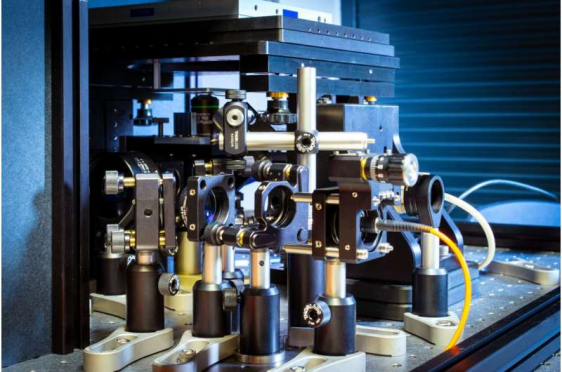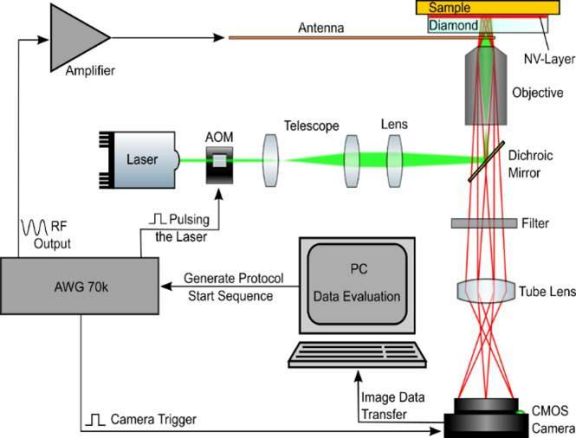Company tel:+86-379-63184520
Contact number:+86-15937921751
Postcode:471000
Email:info@yuxindiamond.com
Address:3-1-508 Luoyang National University Science Park, No. 2 Penglai Road, Jianxi District, Luoyang, China 471000
Fast magnetic imaging with diamond-based quantum sensor technology

by Fraunhofer Institute for Applied Solid State Physics IAF
Fraunhofer IAF’s wide-field magnetometer offers a unique compromise between sensitivity, resolution and speed. Credit: Fraunhofer IAF
Microscopic imaging of magnetic fields, enabled by quantum sensing, allows the measurement of the unique magnetic fingerprint of objects. This opens the door for fundamentally new applications in various fields such as materials testing or biomedicine.
Fraunhofer IAF has developed an innovative method using fast camera images in the form of an improved wide-field magnetometer. The system offers a unique compromise of sensitivity, resolution and speed. It will be presented at LASER World of QUANTUM 2023, held June 27–30 in Munich, as part of the Quantum Sensing Hub Freiburg, in which the institutes Fraunhofer IAF, IPM and IWM pool their expertise in the field of quantum magnetometry.
Researchers at the Fraunhofer Institute for Applied Solid State Physics IAF have managed to harness the great potential of quantum sensor technology based on nitrogen-vacancy (NV) centers in a unique measurement setup. Their wide-field magnetometer enables the magnetic stray field of a sample to be measured rapidly over a large range. Its high measurement accuracy is characterized by a resolution down to the nanometer range and is absolutely quantifiable.
This measurement method opens up new avenues in metrology and is suitable for various industries such as (nano-)electronics, material sciences or biomedicine due to its wide range of applications, from inorganic to organic samples.
The innovative measurement system was developed in the course of the Fraunhofer lead project QMag. In the course of the project, a concentrated magnetometry expertise and infrastructure has developed in Freiburg im Breisgau at the three institutes Fraunhofer IAF, IPM and IWM, which together form the Quantum Sensing Hub Freiburg.

Schematic structure of the measuring principle of the wide-field magnetometer. Due to the direct contact of the sample with the diamond sensor, magnetic nanoparticles can be measured precisely and quickly. Credit: Fraunhofer IAF
Magnetometry with diamond
Wide-field magnetometry is based on NV centers in thin diamond films and is a young approach in quantum sensing. The measurement setup developed at Fraunhofer IAF uses an arbitrary waveform generator (AWG), which generates microwave radiation and triggers a laser and the recording time window of a camera with nanosecond precision. By using different measurement protocols, this allows for high flexibility and precision of measurements.
"The wide-field magnetometer benefits not only from our improved setup, but also from the growth process developed at Fraunhofer IAF for diamond plates, which we use as sensors," explains Dr. Jan Jeske, deputy business unit manager quantum devices at Fraunhofer IAF. The substrates grown at the institute are based on (100)-oriented, pure, undoped diamond of type "IIa" with a thickness of 500 μm and an area of 4 x 4 mm. This substrate is overgrown with a thin layer in which the NV centers for the sensor application are generated close to the sample.

Measurement advantages of the wide-field magnetometer
In materials science, experimental methods are used to characterize polycrystalline materials in order to obtain a microscopic understanding of the macroscopic material behavior. This makes it possible to better understand materials and optimize their properties. However, current methods usually rely on long measurement times and large experimental facilities. Often, vacuum conditions or high-energy particles are also necessary, which can have a detrimental effect on the sample material.
Wide-field magnetometry based on NV centers is an alternative, non-invasive method that operates at room temperature. This opens up new possibilities for insights into the microscopic magnetic field distribution, which has great potential for material analyses. The system is not limited to inorganic material samples, but can also be applied to organic samples due to its comparatively low demands on the measurement environment. These measurement properties, coupled with the high measurement speed of the method developed at Fraunhofer IAF, allow even complex measurements such as fluctuations, alternating fields and alternating current (AC) measurements—paving the way for new material analysis methods.
Provided by Fraunhofer Institute for Applied Solid State Physics IAF
Source: https://phys.org







